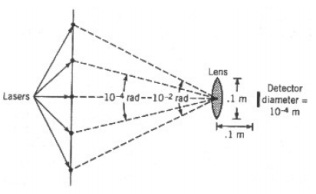Assignment:
Problem 1
An optical receiver (λ=1.06µm) has a 3-in aperture and a 1cm detector. Find the following:
a) diffraction-limited field of view
b) receiver field of view
c) how many field modes can the receiver resolve
d) how far off the normal axis in angle (deg or rad) can a point source be before it is not detectable
Problem 2
Five laser sources transmit plane waves to an optical receiver, as shown below. Each laser produces intensity of 10-6 W/m2 at the receiver.
a) estimate the total power detected by the detector
b) what is the collected power if the lens is removed and the detector is placed directly in the receiver plane?

Problem 3
A 1.55µm laser transmits a plane wave that produces the intensity of 10-6 W/m2 at the receiver, which has a 6-inch aperture lens with a focal length of 5 inches. Use software of your choice (e.g. MATLAB) to plot intensity of the focused beam as function of radial distance ρ (Hint - look at the solution of the Fraunhofer diffraction integral for a plane wave).
Problem 4
Find background power produced from a night sky and the moon in the field of view. Assume the following parameters for the receiver: 10cm lens, wavelength bandwidth ?λ=0.01µm, 100µrad field of view angle, and operating at 10µm. Use radiance/irradiance function graphs posted on Blackboard.
Problem 5
An optical link is established between two satellites separated by 400km. The transmitting station has a 10-inch lens and a 1W, 1.55µm laser source that emits a Gaussian beam. The receiver that has a 20-inch lens requires at least 1µW to detect the signal.
a) calculate the link margin
b) plot the value of the link margin as function of the pointing errors due to satellite vibrations (Hint- consider the off-axis gain). What is the largest value of θoff which keeps the received signal at the acceptable level?
Attachment:- Spectral radiance-irradiance functions.rar